Two-Level vs. Three-Level vs. MMC: A Power Converter Comparison
VerifiedAdded on 2023/06/15
|12
|954
|397
Report
AI Summary
This report provides a comparative analysis of different power electronic converter topologies, focusing on two-level, three-level, and modular multilevel converters (MMC). It discusses the operating principles, advantages, and disadvantages of each topology. The two-level converter, known for its simplicity and low cost, suffers from high harmonic distortion. The three-level converter improves harmonics but faces challenges in DC capacitor voltage balancing and uneven loss distribution. The MMC offers superior harmonic performance and scalability but is more complex and expensive. The report concludes with a comparison of these converters based on voltage levels, construction complexity, efficiency, and control challenges. References to various research publications and books are included to support the analysis. Desklib provides access to this report and numerous other study resources for students.
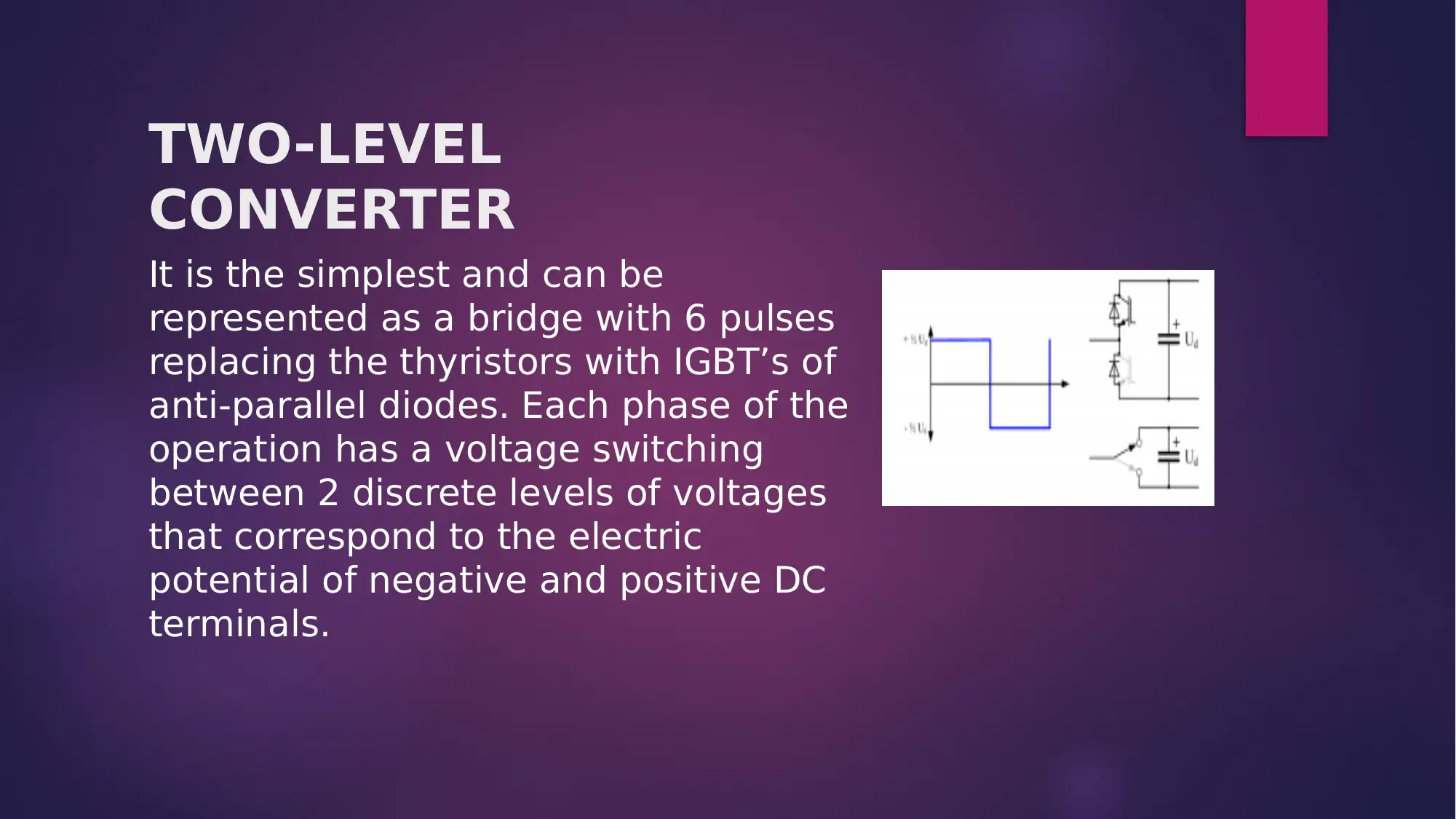
TWO-LEVEL
CONVERTER
It is the simplest and can be
represented as a bridge with 6 pulses
replacing the thyristors with IGBT’s of
anti-parallel diodes. Each phase of the
operation has a voltage switching
between 2 discrete levels of voltages
that correspond to the electric
potential of negative and positive DC
terminals.
CONVERTER
It is the simplest and can be
represented as a bridge with 6 pulses
replacing the thyristors with IGBT’s of
anti-parallel diodes. Each phase of the
operation has a voltage switching
between 2 discrete levels of voltages
that correspond to the electric
potential of negative and positive DC
terminals.
Paraphrase This Document
Need a fresh take? Get an instant paraphrase of this document with our AI Paraphraser
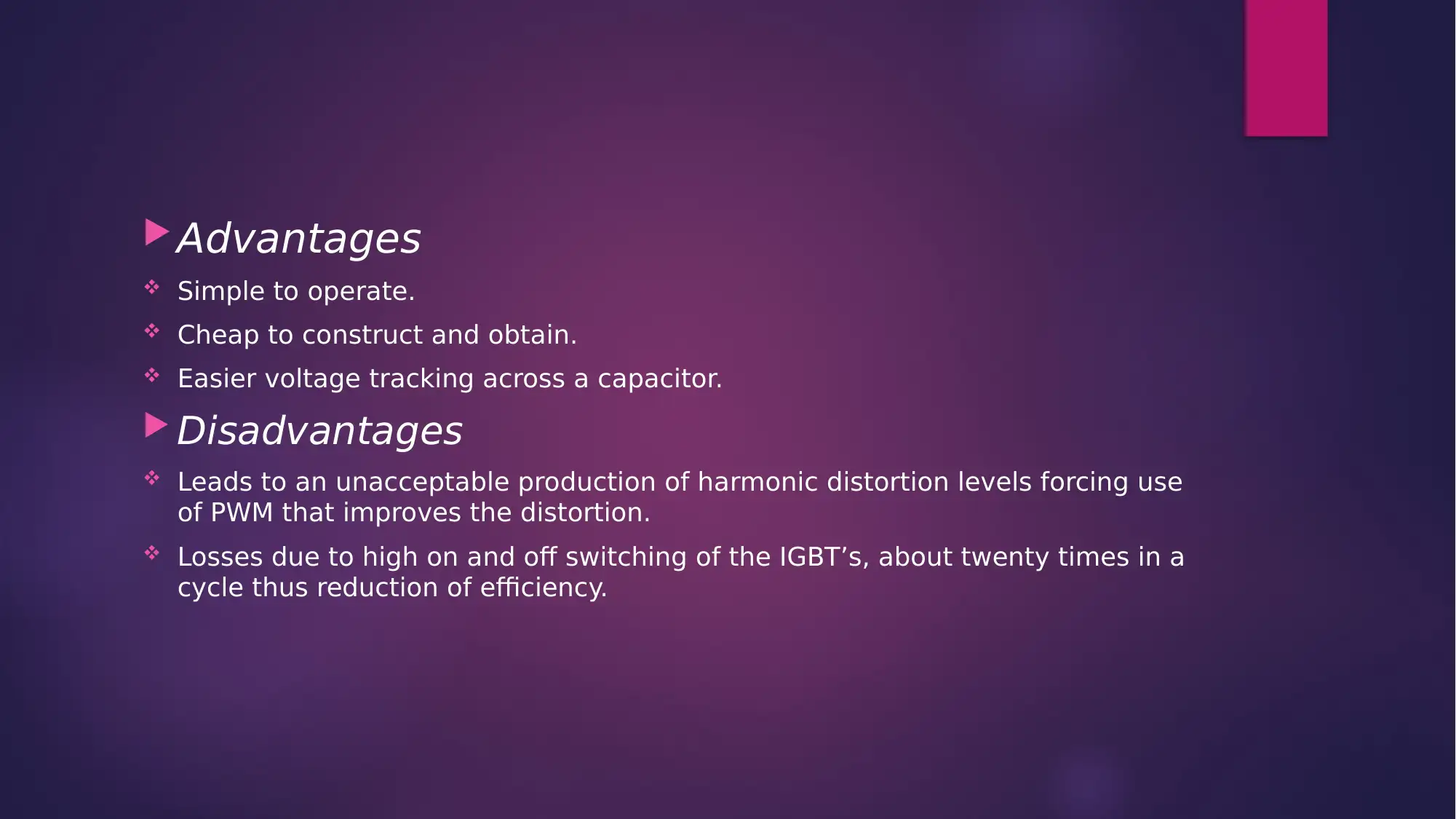
Advantages
Simple to operate.
Cheap to construct and obtain.
Easier voltage tracking across a capacitor.
Disadvantages
Leads to an unacceptable production of harmonic distortion levels forcing use
of PWM that improves the distortion.
Losses due to high on and off switching of the IGBT’s, about twenty times in a
cycle thus reduction of efficiency.
Simple to operate.
Cheap to construct and obtain.
Easier voltage tracking across a capacitor.
Disadvantages
Leads to an unacceptable production of harmonic distortion levels forcing use
of PWM that improves the distortion.
Losses due to high on and off switching of the IGBT’s, about twenty times in a
cycle thus reduction of efficiency.

THREE-LEVEL
CONVERTER
Improves the poor harmonics of
the two-level converter
synthesizing the three discrete
voltage levels found in each
phase. The common type is the
diode clamped converter of 4
valves of IGBT's in each phase
having half rotation of the line-
to-line DC voltage with 2 values
of clamping diodes.
CONVERTER
Improves the poor harmonics of
the two-level converter
synthesizing the three discrete
voltage levels found in each
phase. The common type is the
diode clamped converter of 4
valves of IGBT's in each phase
having half rotation of the line-
to-line DC voltage with 2 values
of clamping diodes.
⊘ This is a preview!⊘
Do you want full access?
Subscribe today to unlock all pages.

Trusted by 1+ million students worldwide
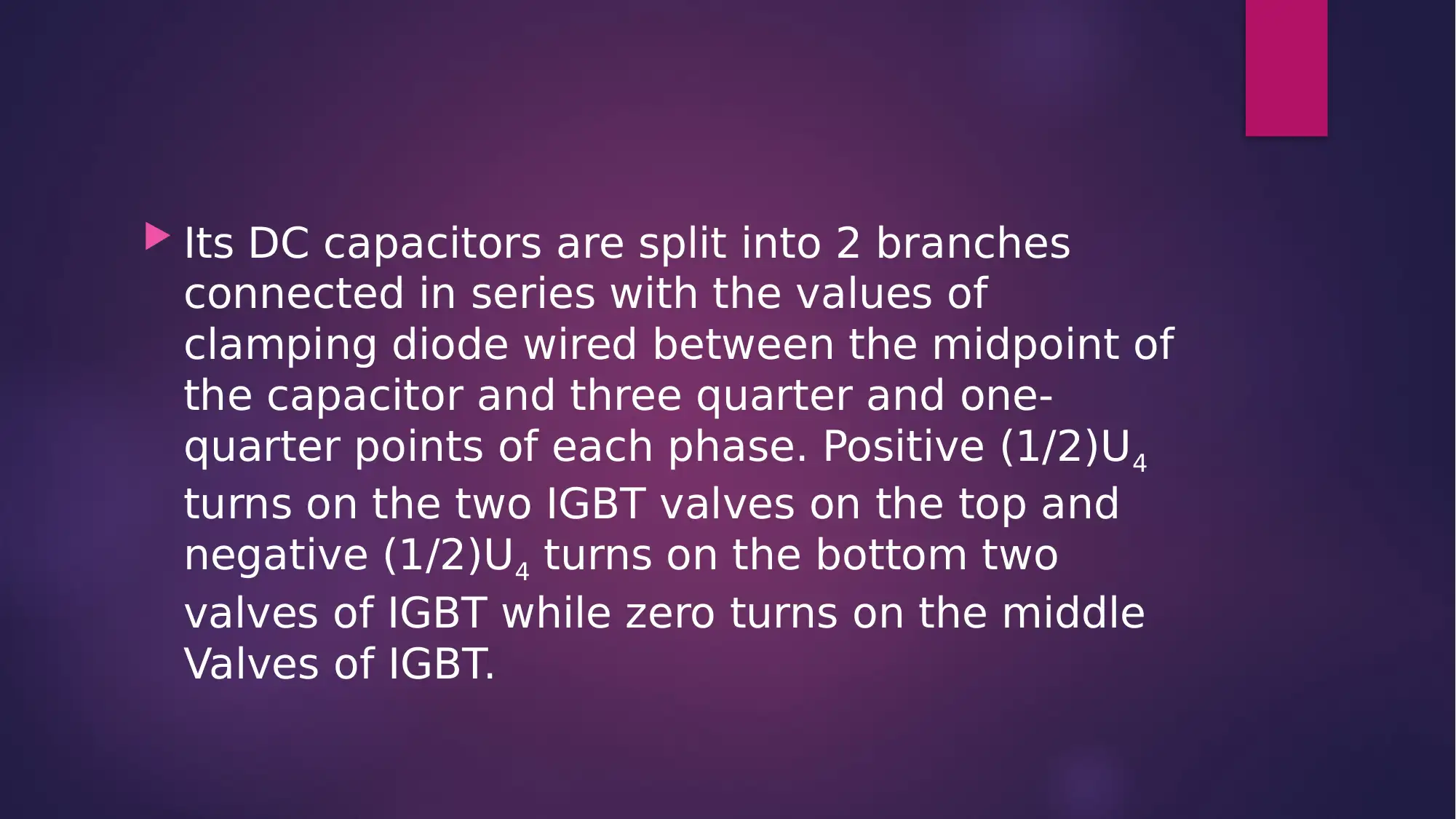
Its DC capacitors are split into 2 branches
connected in series with the values of
clamping diode wired between the midpoint of
the capacitor and three quarter and one-
quarter points of each phase. Positive (1/2)U4
turns on the two IGBT valves on the top and
negative (1/2)U4 turns on the bottom two
valves of IGBT while zero turns on the middle
Valves of IGBT.
connected in series with the values of
clamping diode wired between the midpoint of
the capacitor and three quarter and one-
quarter points of each phase. Positive (1/2)U4
turns on the two IGBT valves on the top and
negative (1/2)U4 turns on the bottom two
valves of IGBT while zero turns on the middle
Valves of IGBT.
Paraphrase This Document
Need a fresh take? Get an instant paraphrase of this document with our AI Paraphraser

Advantages
Allows compensation of three-phase load currents that are
unbalanced in four wire system.
Disadvantages
Poor voltage balancing on its DC capacitors.
Uneven distribution of losses between devices.
The excessive necessity of clamping diodes during higher voltage
levels.
Allows compensation of three-phase load currents that are
unbalanced in four wire system.
Disadvantages
Poor voltage balancing on its DC capacitors.
Uneven distribution of losses between devices.
The excessive necessity of clamping diodes during higher voltage
levels.

Modular Multi-LEVEL
CONVERTER
MMC has 6 valves that each
have a connection from one
terminal of ac to one terminal of
DC. The difference occurs where
the MMC valves have separate
voltage source control as
opposed to two-level converters
where the ICBT valves are
connected in series controlled
with high voltage.
CONVERTER
MMC has 6 valves that each
have a connection from one
terminal of ac to one terminal of
DC. The difference occurs where
the MMC valves have separate
voltage source control as
opposed to two-level converters
where the ICBT valves are
connected in series controlled
with high voltage.
⊘ This is a preview!⊘
Do you want full access?
Subscribe today to unlock all pages.

Trusted by 1+ million students worldwide
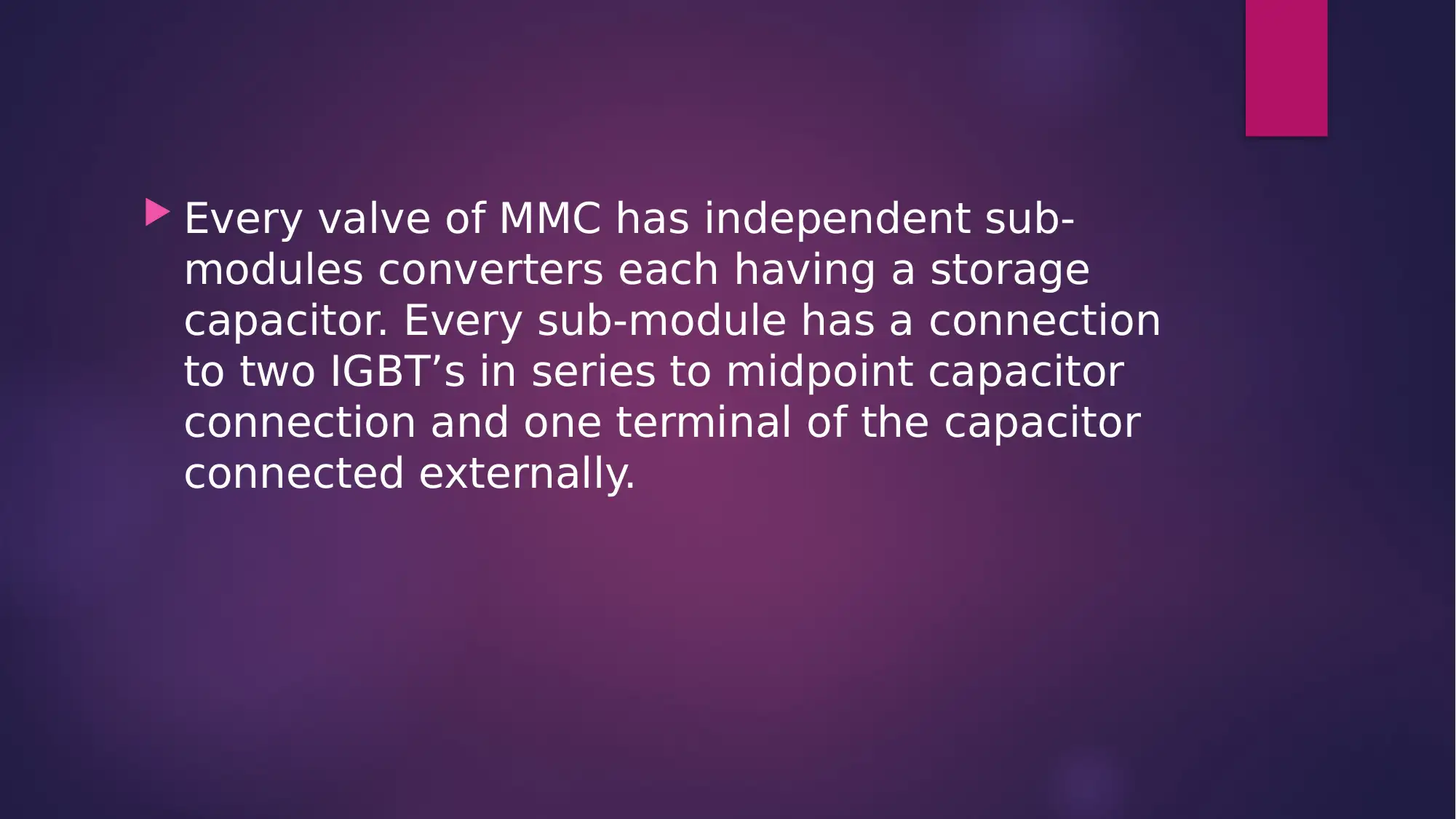
Every valve of MMC has independent sub-
modules converters each having a storage
capacitor. Every sub-module has a connection
to two IGBT’s in series to midpoint capacitor
connection and one terminal of the capacitor
connected externally.
modules converters each having a storage
capacitor. Every sub-module has a connection
to two IGBT’s in series to midpoint capacitor
connection and one terminal of the capacitor
connected externally.
Paraphrase This Document
Need a fresh take? Get an instant paraphrase of this document with our AI Paraphraser
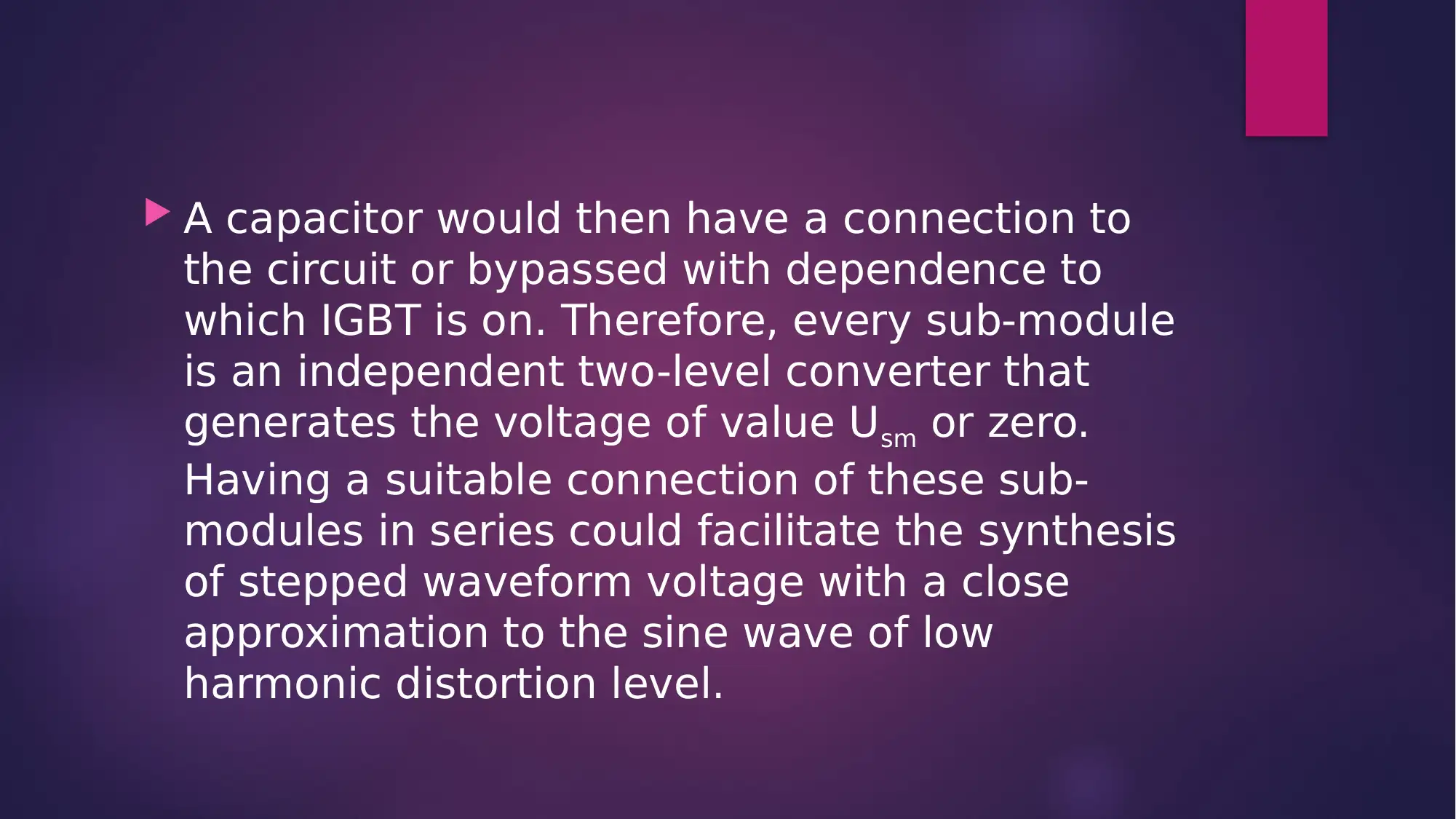
A capacitor would then have a connection to
the circuit or bypassed with dependence to
which IGBT is on. Therefore, every sub-module
is an independent two-level converter that
generates the voltage of value Usm or zero.
Having a suitable connection of these sub-
modules in series could facilitate the synthesis
of stepped waveform voltage with a close
approximation to the sine wave of low
harmonic distortion level.
the circuit or bypassed with dependence to
which IGBT is on. Therefore, every sub-module
is an independent two-level converter that
generates the voltage of value Usm or zero.
Having a suitable connection of these sub-
modules in series could facilitate the synthesis
of stepped waveform voltage with a close
approximation to the sine wave of low
harmonic distortion level.
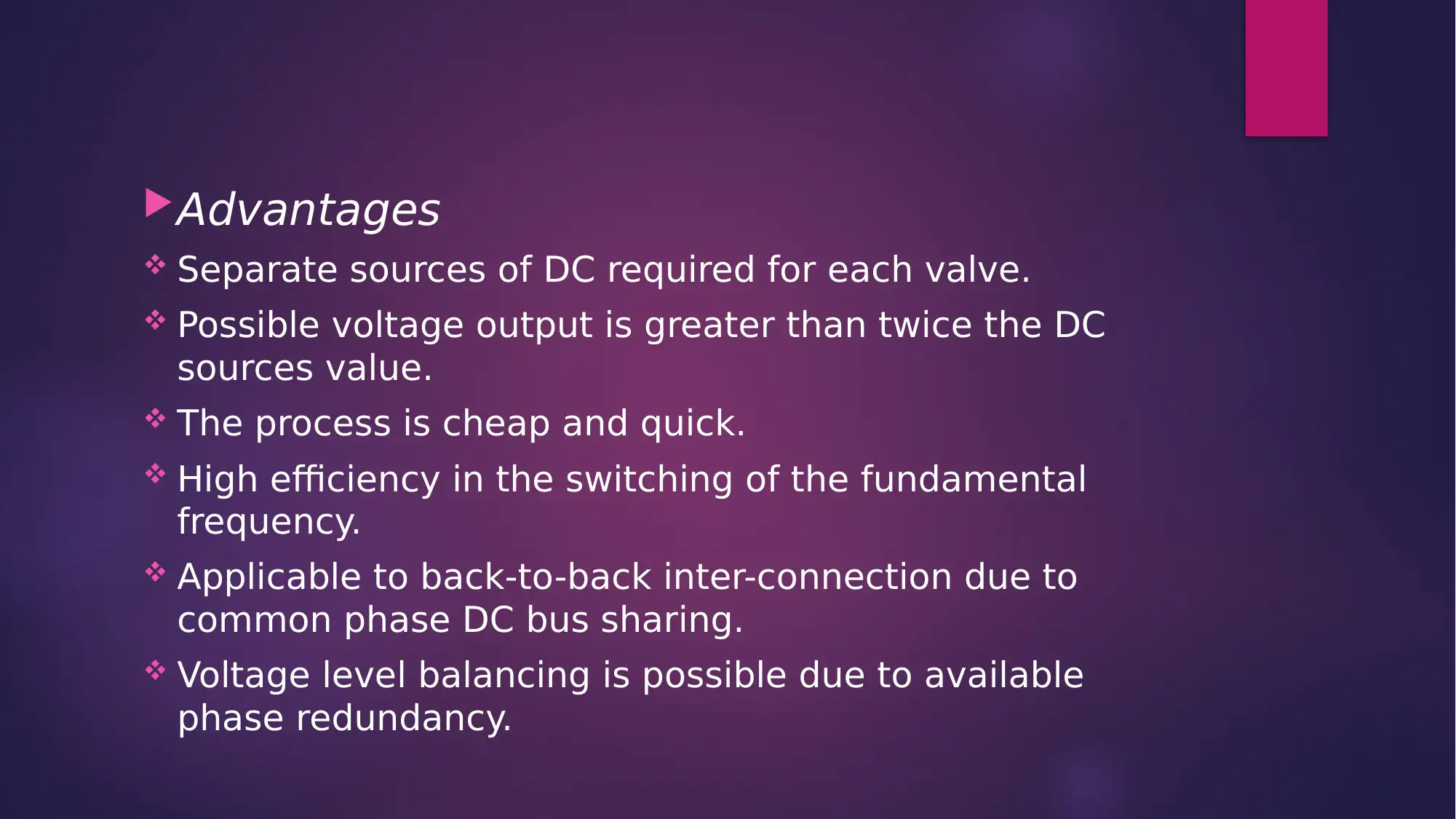
Advantages
Separate sources of DC required for each valve.
Possible voltage output is greater than twice the DC
sources value.
The process is cheap and quick.
High efficiency in the switching of the fundamental
frequency.
Applicable to back-to-back inter-connection due to
common phase DC bus sharing.
Voltage level balancing is possible due to available
phase redundancy.
Separate sources of DC required for each valve.
Possible voltage output is greater than twice the DC
sources value.
The process is cheap and quick.
High efficiency in the switching of the fundamental
frequency.
Applicable to back-to-back inter-connection due to
common phase DC bus sharing.
Voltage level balancing is possible due to available
phase redundancy.
⊘ This is a preview!⊘
Do you want full access?
Subscribe today to unlock all pages.

Trusted by 1+ million students worldwide

Disadvantages
In the transmission of real power, there is poor
switching utilization and efficiency.
Increased number of capacitors makes the
converter more bulky and expensive.
Complicated control in voltage level tracking
across the capacitors.
In the transmission of real power, there is poor
switching utilization and efficiency.
Increased number of capacitors makes the
converter more bulky and expensive.
Complicated control in voltage level tracking
across the capacitors.
Paraphrase This Document
Need a fresh take? Get an instant paraphrase of this document with our AI Paraphraser
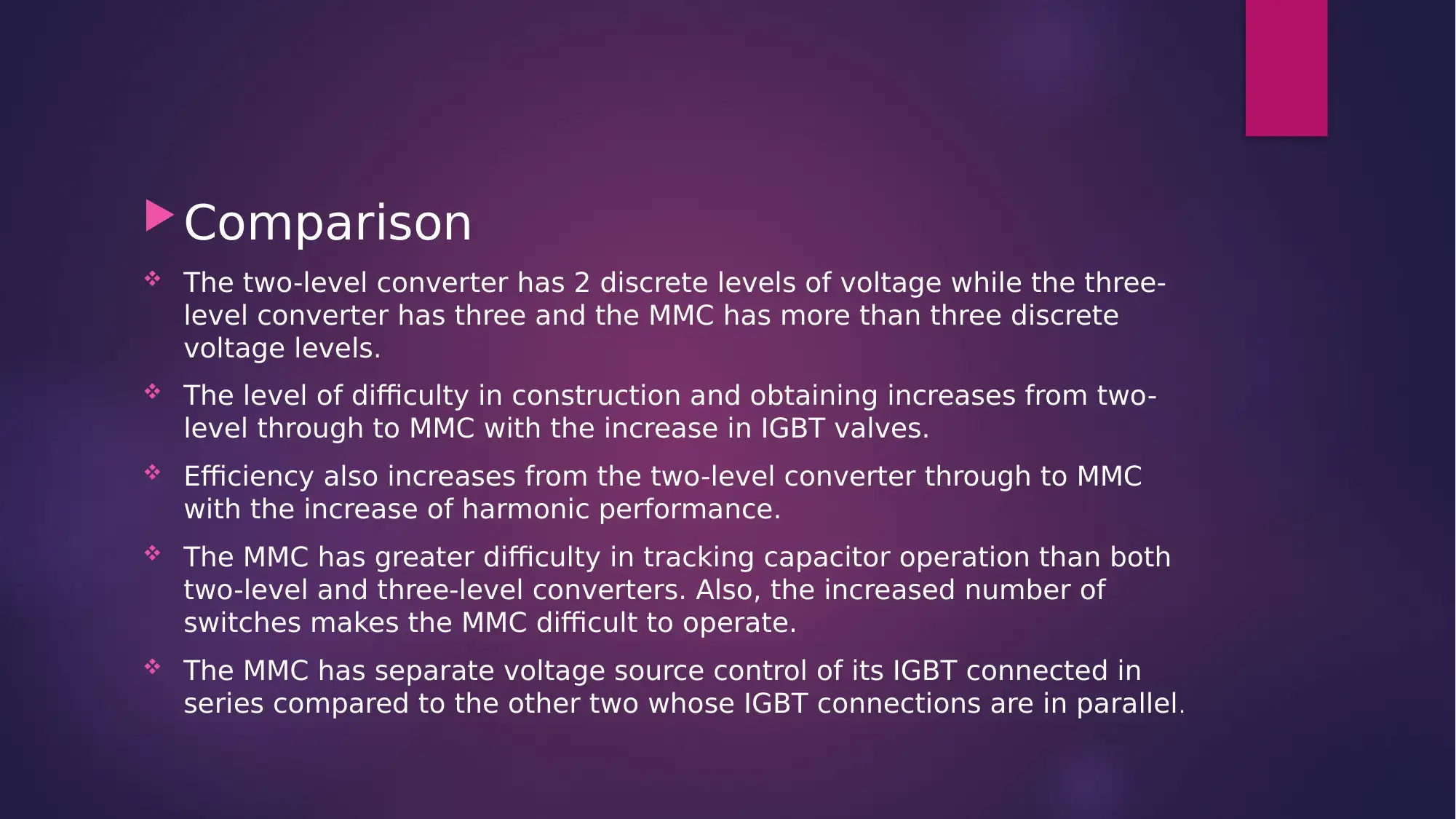
Comparison
The two-level converter has 2 discrete levels of voltage while the three-
level converter has three and the MMC has more than three discrete
voltage levels.
The level of difficulty in construction and obtaining increases from two-
level through to MMC with the increase in IGBT valves.
Efficiency also increases from the two-level converter through to MMC
with the increase of harmonic performance.
The MMC has greater difficulty in tracking capacitor operation than both
two-level and three-level converters. Also, the increased number of
switches makes the MMC difficult to operate.
The MMC has separate voltage source control of its IGBT connected in
series compared to the other two whose IGBT connections are in parallel.
The two-level converter has 2 discrete levels of voltage while the three-
level converter has three and the MMC has more than three discrete
voltage levels.
The level of difficulty in construction and obtaining increases from two-
level through to MMC with the increase in IGBT valves.
Efficiency also increases from the two-level converter through to MMC
with the increase of harmonic performance.
The MMC has greater difficulty in tracking capacitor operation than both
two-level and three-level converters. Also, the increased number of
switches makes the MMC difficult to operate.
The MMC has separate voltage source control of its IGBT connected in
series compared to the other two whose IGBT connections are in parallel.

References
T. Remus, L. Marco and R. Pedro, Grid Converters for Photovoltaic and Wind Power
Systems, Mönchengladbach: John Wiley & Sons, 2011.
C. Maurizio, P. Marcello and V. Gianpaolo, Power Converters and AC Electrical Drives
with Linear Neural Networks, Bielefeld: CRC Press, 2017.
W. Bin, High-Power Converters and AC Drives, Hamburg: John Wiley & Sons, 2007.
L. Yushan, A.-R. Haitham, G. Baoming, B. Frede, E. Omar and C. L. Poh, Impedance
Source Power Electronic Converters, Frankfurt: John Wiley & Sons, 2016.
L. Fang and Y. Hong, Advanced DC/AC Inverters: Applications in Renewable Energy,
Bielefeld: CRC Press, 2016.
Q. Li and J. Chen, Advanced Materials And Energy Sustainability - Proceedings Of The
2016 International Conference On Advanced Materials And Energy Sustainability
(Ames2016), World Scientific, 2017.
S. Kamran, H. Lennart, N. Hans-Peter, N. Staffan and T. Remus, Design, Control, and
Application of Modular Multilevel Converters for HVDC Transmission Systems,
Bremen: John Wiley & Sons, 2016.
L. Leonard, Electric Power Generation, Transmission, and Distribution, Third Edition,
Bonn: CRC Press, 2016.
A. Sergio, S. A. and I. Maria, Multilevel Converters for Industrial Applications,
Bremen: CRC Press, 2016.
T. Remus, L. Marco and R. Pedro, Grid Converters for Photovoltaic and Wind Power
Systems, Mönchengladbach: John Wiley & Sons, 2011.
C. Maurizio, P. Marcello and V. Gianpaolo, Power Converters and AC Electrical Drives
with Linear Neural Networks, Bielefeld: CRC Press, 2017.
W. Bin, High-Power Converters and AC Drives, Hamburg: John Wiley & Sons, 2007.
L. Yushan, A.-R. Haitham, G. Baoming, B. Frede, E. Omar and C. L. Poh, Impedance
Source Power Electronic Converters, Frankfurt: John Wiley & Sons, 2016.
L. Fang and Y. Hong, Advanced DC/AC Inverters: Applications in Renewable Energy,
Bielefeld: CRC Press, 2016.
Q. Li and J. Chen, Advanced Materials And Energy Sustainability - Proceedings Of The
2016 International Conference On Advanced Materials And Energy Sustainability
(Ames2016), World Scientific, 2017.
S. Kamran, H. Lennart, N. Hans-Peter, N. Staffan and T. Remus, Design, Control, and
Application of Modular Multilevel Converters for HVDC Transmission Systems,
Bremen: John Wiley & Sons, 2016.
L. Leonard, Electric Power Generation, Transmission, and Distribution, Third Edition,
Bonn: CRC Press, 2016.
A. Sergio, S. A. and I. Maria, Multilevel Converters for Industrial Applications,
Bremen: CRC Press, 2016.
⊘ This is a preview!⊘
Do you want full access?
Subscribe today to unlock all pages.

Trusted by 1+ million students worldwide
1 out of 12
Your All-in-One AI-Powered Toolkit for Academic Success.
+13062052269
info@desklib.com
Available 24*7 on WhatsApp / Email
![[object Object]](/_next/static/media/star-bottom.7253800d.svg)
Unlock your academic potential
Copyright © 2020–2025 A2Z Services. All Rights Reserved. Developed and managed by ZUCOL.
